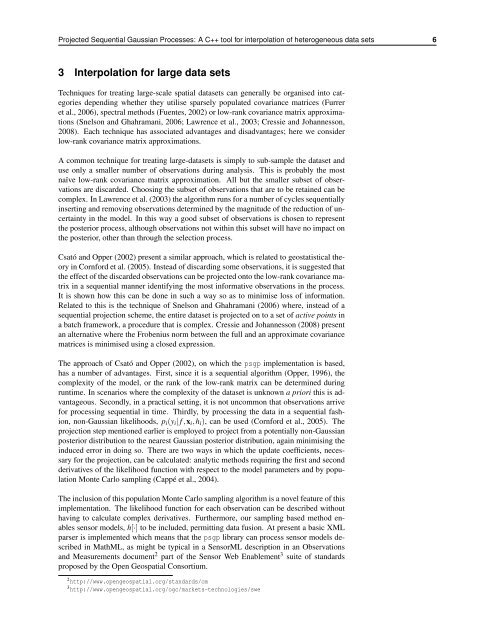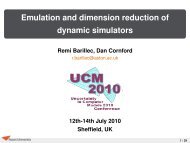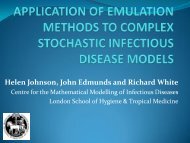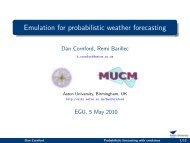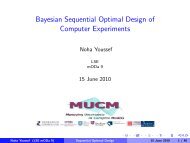Projected Sequential Gaussian Processes: A C++ tool for ... - MUCM
Projected Sequential Gaussian Processes: A C++ tool for ... - MUCM
Projected Sequential Gaussian Processes: A C++ tool for ... - MUCM
Create successful ePaper yourself
Turn your PDF publications into a flip-book with our unique Google optimized e-Paper software.
<strong>Projected</strong> <strong>Sequential</strong> <strong>Gaussian</strong> <strong>Processes</strong>: A <strong>C++</strong> <strong>tool</strong> <strong>for</strong> interpolation of heterogeneous data sets 6<br />
3 Interpolation <strong>for</strong> large data sets<br />
Techniques <strong>for</strong> treating large-scale spatial datasets can generally be organised into categories<br />
depending whether they utilise sparsely populated covariance matrices (Furrer<br />
et al., 2006), spectral methods (Fuentes, 2002) or low-rank covariance matrix approximations<br />
(Snelson and Ghahramani, 2006; Lawrence et al., 2003; Cressie and Johannesson,<br />
2008). Each technique has associated advantages and disadvantages; here we consider<br />
low-rank covariance matrix approximations.<br />
A common technique <strong>for</strong> treating large-datasets is simply to sub-sample the dataset and<br />
use only a smaller number of observations during analysis. This is probably the most<br />
naïve low-rank covariance matrix approximation. All but the smaller subset of observations<br />
are discarded. Choosing the subset of observations that are to be retained can be<br />
complex. In Lawrence et al. (2003) the algorithm runs <strong>for</strong> a number of cycles sequentially<br />
inserting and removing observations determined by the magnitude of the reduction of uncertainty<br />
in the model. In this way a good subset of observations is chosen to represent<br />
the posterior process, although observations not within this subset will have no impact on<br />
the posterior, other than through the selection process.<br />
Csató and Opper (2002) present a similar approach, which is related to geostatistical theory<br />
in Corn<strong>for</strong>d et al. (2005). Instead of discarding some observations, it is suggested that<br />
the effect of the discarded observations can be projected onto the low-rank covariance matrix<br />
in a sequential manner identifying the most in<strong>for</strong>mative observations in the process.<br />
It is shown how this can be done in such a way so as to minimise loss of in<strong>for</strong>mation.<br />
Related to this is the technique of Snelson and Ghahramani (2006) where, instead of a<br />
sequential projection scheme, the entire dataset is projected on to a set of active points in<br />
a batch framework, a procedure that is complex. Cressie and Johannesson (2008) present<br />
an alternative where the Frobenius norm between the full and an approximate covariance<br />
matrices is minimised using a closed expression.<br />
The approach of Csató and Opper (2002), on which the psgp implementation is based,<br />
has a number of advantages. First, since it is a sequential algorithm (Opper, 1996), the<br />
complexity of the model, or the rank of the low-rank matrix can be determined during<br />
runtime. In scenarios where the complexity of the dataset is unknown a priori this is advantageous.<br />
Secondly, in a practical setting, it is not uncommon that observations arrive<br />
<strong>for</strong> processing sequential in time. Thirdly, by processing the data in a sequential fashion,<br />
non-<strong>Gaussian</strong> likelihoods, pi(yi| f ,xi,hi), can be used (Corn<strong>for</strong>d et al., 2005). The<br />
projection step mentioned earlier is employed to project from a potentially non-<strong>Gaussian</strong><br />
posterior distribution to the nearest <strong>Gaussian</strong> posterior distribution, again minimising the<br />
induced error in doing so. There are two ways in which the update coefficients, necessary<br />
<strong>for</strong> the projection, can be calculated: analytic methods requiring the first and second<br />
derivatives of the likelihood function with respect to the model parameters and by population<br />
Monte Carlo sampling (Cappé et al., 2004).<br />
The inclusion of this population Monte Carlo sampling algorithm is a novel feature of this<br />
implementation. The likelihood function <strong>for</strong> each observation can be described without<br />
having to calculate complex derivatives. Furthermore, our sampling based method enables<br />
sensor models, h[·] to be included, permitting data fusion. At present a basic XML<br />
parser is implemented which means that the psgp library can process sensor models described<br />
in MathML, as might be typical in a SensorML description in an Observations<br />
and Measurements document 2 part of the Sensor Web Enablement 3 suite of standards<br />
proposed by the Open Geospatial Consortium.<br />
2 http://www.opengeospatial.org/standards/om<br />
3 http://www.opengeospatial.org/ogc/markets-technologies/swe


